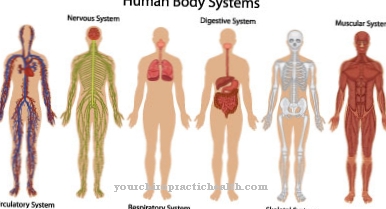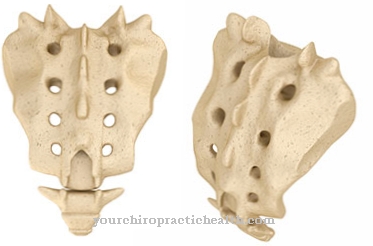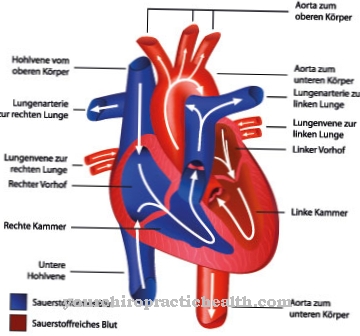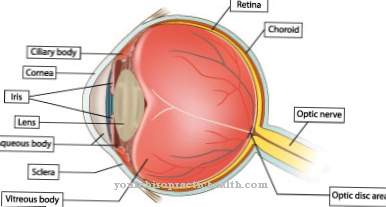A Wilms tumor (nephroblastoma) represents the most common tumor disease of children's kidneys, which affects girls slightly more often than boys. With an early diagnosis and start of therapy, a Wilms tumor can usually be cured in the long term.
What is Wilms Tumor?
As Wilms tumor or. Nephroblastoma is a malignant (malignant) tumor of the kidney that primarily affects children, especially between the ages of 1 and 4.
A Wilms tumor is usually unilateral and tends to metastasize prematurely (formation of daughter tumors), which is often hematogenous (via the blood) in the lungs, brain, liver and regional lymph nodes. Furthermore, a Wilms tumor is associated in some cases with congenital concomitant malformations, which mainly affect the eye (aniridia or lack of iris) or the urethra (urogenital malformations).
In addition, a Wilms tumor is primarily characterized by painless tumor swelling in the area of the abdominal wall and is only rarely associated with pain, hematuria (blood in the urine) or hypertension (high blood pressure).
causes
The causes for one Wilms tumor could not yet be clarified. Due to the fact that a nephroblastoma can in many cases be associated with congenital concomitant malformations or genetic diseases such as Beckwith-Wiedemann syndrome, WAGR syndrome or Denys-Drash syndrome, genetic factors are assumed for the manifestation of the tumor disease .
It is assumed that the so-called Wilms tumor gene WT-1, which plays an important role in the physiological development of the kidneys, and WT-2, which, like WT-1, is located on chromosome 11, are responsible for the manifestation of a Wilms' tumor could contribute.
In addition, the analysis of the tumor cells revealed a loss of DNA on the short arm of chromosome 11, which is normally responsible for tumor suppression.
Symptoms, ailments & signs
Wilms' tumor (also called nephroblastoma) is a special type of kidney tumor that occurs particularly in children. In 85 percent of the cases, the children who suffer from a Wilms tumor are younger than five years. In 11 percent of all cases the Wilms tumor appears symptom-free and was discovered by chance during a preventive examination.
If the Wils tumor shows symptoms, the main symptom is a painless bulging of the abdomen, that is, a bulging of the abdominal wall. In some cases the children complain of pain. Often this bulging, "big" belly is not recognized as a symptom but rather seen as a sign of well-being. In rare cases, blood can be found in the child's urine (hematuria).
Atypical symptoms that may be associated with nephroblastoma are fever, vomiting, problems with the digestive system, or high blood pressure (hypertension). The problems with the digestive system can be loss of appetite or alternating diarrhea and constipation.
In rare cases, there may be an increased level of calcium in the blood (hypercalcaemia). In rare cases, Wilms' tumor also occurs in young or older adults. Here it can make itself felt through flank pain, weight loss and a sudden drop in performance.
Diagnosis & course
There a Wilms tumor causes hardly any symptoms at the beginning, the tumor disease is diagnosed in many cases as part of a routine examination by palpating the abdominal area.
If a painless swelling is found, this can be a first indication of a Wilms tumor. Imaging methods such as sonography (ultrasound), computed tomography (CT), x-ray examinations and magnetic resonance tomography (MRT) are used to confirm the diagnosis. These serve to determine the size and location as well as the spread of the tumor (determination of metastases).
In addition, kidney function can be checked using a creatinine clearance (determination of the creatinine concentration in the urine or serum) and a kidney function scintigraphy (nuclear medicine procedure). A Wilms tumor shows a progressive course with rapid growth and tends to metastasize early. As a rule, however, the prognosis is good with early diagnosis and therapy, and in around 90 percent of cases the affected children can be cured in the long term.
Complications
Wilms' tumor is the most common type of kidney cancer in children. If the tumor is discovered in good time and treated appropriately, there is a good chance that the patient will recover completely and that no serious complications will arise. Nevertheless, crises must be expected during therapy.
A very common complication that occurs with Wilms' tumor is high blood pressure. The hormone-like enzyme renin, which is increasingly produced, causes the vascular lumen to narrow, which leads to an increase in blood pressure. In addition, kidney bleeding can occur because the membrane of Bowman's capsule is damaged.
The blood often initially collects in the renal pelvis, and blood clots can usually be found in the urine. If the internal bleeding is very pronounced, this can lead to a drop in blood pressure and consequent loss of consciousness in the patient. A life-threatening circulatory collapse cannot be ruled out in the case of very heavy internal bleeding.
As with many malignant ulcers, Wilms' tumor is at risk of spreading. Metastases usually form in the lungs, causing the patient to experience chest pain, shortness of breath, and bloody sputum before more serious complications set in.
When should you go to the doctor?
If the child shows unusual behavior, parents should always pay increased attention to the child's behavior or health developments. A doctor should be consulted in the case of whining behavior, severe restlessness or sleep disorders. If unnatural changes, swellings or bulges develop on the body, these should also be clarified as soon as possible. In the event of complaints such as vomiting, nausea or disorders of the digestive tract, the child needs medical care. Loss of appetite, constipation or irregular heartbeat are warning signals from the organism.
To consult a doctor, as serious complications can arise in the event of an unfavorable course of the disease. If existing symptoms persist over a long period of time, if new symptoms develop or if the intensity of the irregularities increases, a doctor should be consulted immediately. Action is required in the event of fever, blood in the urine and disorders of concentration and attention.
Pain and taking a physical posture should be examined and treated more closely. If the physical and mental performance drops, this indicates a health impairment. Sudden change is particularly a cause for concern. If participation in social life decreases and the child's play instinct has decreased within a short period of time, a doctor should be consulted. If you lose weight, you should also see a doctor.
Treatment & Therapy
The therapy of a Wilms tumor usually includes surgical removal of the tumor-bearing kidney (tumor nephrectomy) as well as chemotherapy and radiation therapy measures. The individual measures and their sequence are tailored to the age of the affected child as well as the nature of the tumor and the stage of development of the disease.
For example, in children who are younger than six months, the tumor-bearing kidney is surgically removed directly. In the run-up to the surgical procedure, however, it should be checked whether the second kidney is fully functional. In elderly patients or in the presence of a larger nephroblastoma, the Wilms tumor is first reduced in size by chemotherapeutic measures before it is surgically removed as part of a tumor nephrectomy.
If both kidneys are affected, a surgical procedure aims to preserve the kidneys and, following chemotherapy, only the remaining tumor residues and metastases are removed from the unaffected kidney tissue (tumor enucleation). In rare cases (e.g. advanced stage of the disease or high malignancy of Wilms' tumor), radiation therapy is also required to kill residual tumor or metastases that could not be removed surgically or chemotherapeutically.
Furthermore, following successful therapy, affected children should be regularly checked for recurrences (recurrence of the tumor) as part of follow-up examinations, especially within the first two years after the end of therapy.
prevention
Because the causes for a Wilms tumor are unknown, nephroblastoma cannot be prevented. Children who are affected by genetic diseases that seem to favor the tumor (including Beckwith-Wiedemann syndrome) should be examined by a doctor for a possible Wilms tumor if swelling occurs in the abdominal area. In individual cases, molecular genetic examinations may be necessary to determine a predisposition (disposition) to a Wilms tumor.
Aftercare
After the actual treatment of the Wilms tumor, follow-up care for the affected children is necessary. If a solid tumor has been surgically removed, specialists in oncology and hematology at the children's clinic take care of the follow-up treatment. In most cases, there is no need for radiation treatment after chemotherapy or surgery.
The scope and type of aftercare depend on the stage of the Wilms tumor. As this time is extremely stressful for the affected children and their families, psychosocial support is useful. Qualified psychotherapists show the sick child as well as their parents and siblings how to better deal with the difficult situation.
The check-ups are also an important part of the follow-up care. They have to take place regularly because the cancer can recur in the two years after the therapy. If an ulcer actually does show up again, it can be treated early. The close-knit examinations include sonography (ultrasound examination). Magnetic resonance tomography is also possible. If the suspicion of a relapse is confirmed, this is fought again with chemotherapy.
Follow-up care also includes regular lung checks using X-ray examinations.There is a risk of metastases (daughter tumors) in the lungs in the first two years after cancer therapy. If there are no recurrences or metastases after five years, the child is considered cured, so that no more check-ups need to take place.
You can do that yourself
The development of the tumor disease occurs in most cases in children. Therefore, relatives and especially the parents are responsible for providing the patient with the best possible support in everyday life. The self-help measures concentrate on working closely and harmoniously with the treating team of doctors and on following their instructions.
Studies repeatedly show that mental and mental stability is particularly important when coping with the disease. Therefore, conflicts and stressful situations should be avoided as much as possible. The focus is on activities to promote joie de vivre and wellbeing. At the same time, the child should receive lessons and be given the best possible support in the natural learning process.
The child should be adequately informed about the disease and its consequences. The occurrence of possible symptoms should be discussed with the child so that situations of fear or panic can be reduced to a minimum. Since the disease is associated with numerous health restrictions and long-term therapy is required, the child must be prepared emotionally in good time for the further course of action. Contact with other children is important during this time and should therefore be encouraged. A mutual exchange can be helpful in dealing with the circumstances. The closeness to family members is also extremely important during the entire treatment period.






.jpg)






.jpg)

.jpg)
.jpg)











.jpg)